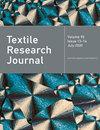A review of deep learning within the framework of artificial intelligence for enhanced fiber and yarn quality
IF 1.9
4区 工程技术
Q2 MATERIALS SCIENCE, TEXTILES
引用次数: 0
Abstract
In the textile production chain, fibers serve as the foundational units for yarn, and yarn, in turn, acts as a fundamental component for woven or knitted fabrics. The quality control of fabrics is intricately tied to the management of fibers and yarns. Traditional laboratory methods have been utilized to assess their quality, but the advent of machine learning and deep learning introduces a transformative approach. This review explores the application of machine learning methods such as principal component analysis, support vector machine, and deep learning methods such as artificial neural networks, convolutional neural networks, you look only once, and genetic algorithms to predict various properties of fibers and yarns. In the context of fibers, the review delves into topics such as cotton fiber grading based on color, characterization of jute fiber, and the identification of medullation in alpaca fibers. For yarns, the focus shifts to predicting parameters such as yarn tenacity, evenness, abrasion index of spun yarns, inspection of false twist textured yarn packages, breaking elongation of ring-spun cotton yarns, tensile properties of cotton/spandex yarns, yarn thickness, and yarn hairiness. The review also provides insights into the advantages and limitations of the discussed studies. Despite the comprehensiveness of this review, it is acknowledged that there might be additional relevant work not covered. The review encourages the sharing of data to expedite the integration of these technologies in future applications within the field.人工智能框架下的深度学习在提高纤维和纱线质量方面的应用综述
在纺织品生产链中,纤维是纱线的基本单位,而纱线又是机织或针织面料的基本组成部分。织物的质量控制与纤维和纱线的管理密切相关。传统的实验室方法一直被用来评估它们的质量,但机器学习和深度学习的出现引入了一种变革性的方法。本综述探讨了主成分分析、支持向量机等机器学习方法和人工神经网络、卷积神经网络、只看一次和遗传算法等深度学习方法在预测纤维和纱线各种特性方面的应用。在纤维方面,综述深入探讨了基于颜色的棉纤维分级、黄麻纤维的特征描述以及羊驼毛纤维的延髓识别等主题。在纱线方面,重点转向预测纱线的韧性、均匀度、纺纱的磨损指数、假捻纹理纱包的检查、环锭纺棉纱的断裂伸长率、棉/氨纶纱的拉伸性能、纱线厚度和纱线毛羽等参数。综述还对所讨论研究的优势和局限性进行了深入分析。尽管本综述内容全面,但也承认可能还有其他相关工作没有涉及。本综述鼓励共享数据,以加快这些技术在该领域未来应用中的整合。
本文章由计算机程序翻译,如有差异,请以英文原文为准。
求助全文
约1分钟内获得全文
求助全文
来源期刊

Textile Research Journal
工程技术-材料科学:纺织
CiteScore
4.00
自引率
21.70%
发文量
309
审稿时长
1.5 months
期刊介绍:
The Textile Research Journal is the leading peer reviewed Journal for textile research. It is devoted to the dissemination of fundamental, theoretical and applied scientific knowledge in materials, chemistry, manufacture and system sciences related to fibers, fibrous assemblies and textiles. The Journal serves authors and subscribers worldwide, and it is selective in accepting contributions on the basis of merit, novelty and originality.
 求助内容:
求助内容: 应助结果提醒方式:
应助结果提醒方式:


